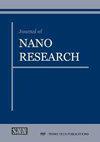不同方法致密化碳纳米管薄膜的显著电热行为和性能稳定性
IF 1
4区 材料科学
Q4 MATERIALS SCIENCE, MULTIDISCIPLINARY
引用次数: 0
摘要
本研究采用体积比为4:1的乙醇/水、丙酮/水、乙酸/水、硫酸/水进行致密化,并经过轧制工艺制备了碳纳米管薄膜。然后,研究了这些碳纳米管薄膜的电热性能、力学性能和性能稳定性,并对其机理进行了分析。根据我们的研究,上述方法具有5秒内快速电热响应的能力,在5V的低输入电压下具有高于120~160°C的稳态温度,以及优异的电加热循环稳定性,与以往报道的同类碳纳米管薄膜相比,结果更好。处理后的碳纳米管薄膜的电热性能和力学性能均优于由碳纳米管气溶胶压制而成的碳纳米管薄膜,且在溶剂中浸泡0.5h并滚动时可同时获得最佳效果。结果与前三种混合溶剂处理和滚压处理的结果相似,但经硫酸/水处理和滚压处理的碳纳米管薄膜由于p型掺杂和净化,其电学和电热性能比其他处理的碳纳米管薄膜有明显改善,这可以增强碳纳米管薄膜的电导率,而力学性能与其他处理的薄膜相比没有下降。特别是碳纳米管薄膜由于其结构和形态的稳定性,通过反复电加热,其电学和力学性能不会发生变化,从而使其具有非常稳定的电热性能,为其作为长期稳定的加热器应用奠定了基础。最后,提出了电加热膜性能稳定的机理。本文章由计算机程序翻译,如有差异,请以英文原文为准。
Remarkable Electrothermal Behaviors and Performance Stability of Carbon Nanotube Films Densifying with Various Methods
In this study, carbon nanotube films, densifying with ethanol/water, acetone/water, acetic acid/water, sulfuric acid/water with volume rate of 4:1 and following rolling process, were manufactured. Afterwards, the electrothermal, mechanical properties and performance stability of these carbon nanotube films were investigated, along with mechanism analysis. Based on our investigations, the ability of rapid electrothermal response within 5 second, higher steady-state temperature of above 120~160°C at low input voltages of 5V, excellent cycling stability of electrical heating are reported by the aforementioned methods, revealing better outcome as compared with previous reports of congeneric carbon nanotube films. The electrothermal and mechanical properties of treated carbon nanotube films were superior to carbon nanotube film pressed from carbon nanotube aerosol, and the best outcomes could be synchronously achieved at an immersion of 0.5h in solvents and rolling. The consequences, which are attributable to treatments by the first three mixed solvents as well as rolling, were similar, however, the electrical and electrothermal properties of carbon nanotube film treated with sulfuric acid/water and rolling were significantly improved comparative to others due to p-type doping and purification, which could enhance the electrical conductivity of carbon nanotube film, while the mechanical property was not degraded compared to films treated by other ways. Particularly, electrical and mechanical properties of carbon nanotube films were unchanged through repeated electrical heating owing to the stability of their structure and morphology, which contributed to exceedingly stable electrothermal property and established foundation for application as heater with long-term stability. Lastly, we have also proposed the mechanism concerning performance stability of electrical heating film.
求助全文
通过发布文献求助,成功后即可免费获取论文全文。
去求助
来源期刊

Journal of Nano Research
工程技术-材料科学:综合
CiteScore
2.40
自引率
5.90%
发文量
55
审稿时长
4 months
期刊介绍:
"Journal of Nano Research" (JNanoR) is a multidisciplinary journal, which publishes high quality scientific and engineering papers on all aspects of research in the area of nanoscience and nanotechnologies and wide practical application of achieved results.
"Journal of Nano Research" is one of the largest periodicals in the field of nanoscience and nanotechnologies. All papers are peer-reviewed and edited.
Authors retain the right to publish an extended and significantly updated version in another periodical.
 求助内容:
求助内容: 应助结果提醒方式:
应助结果提醒方式:


